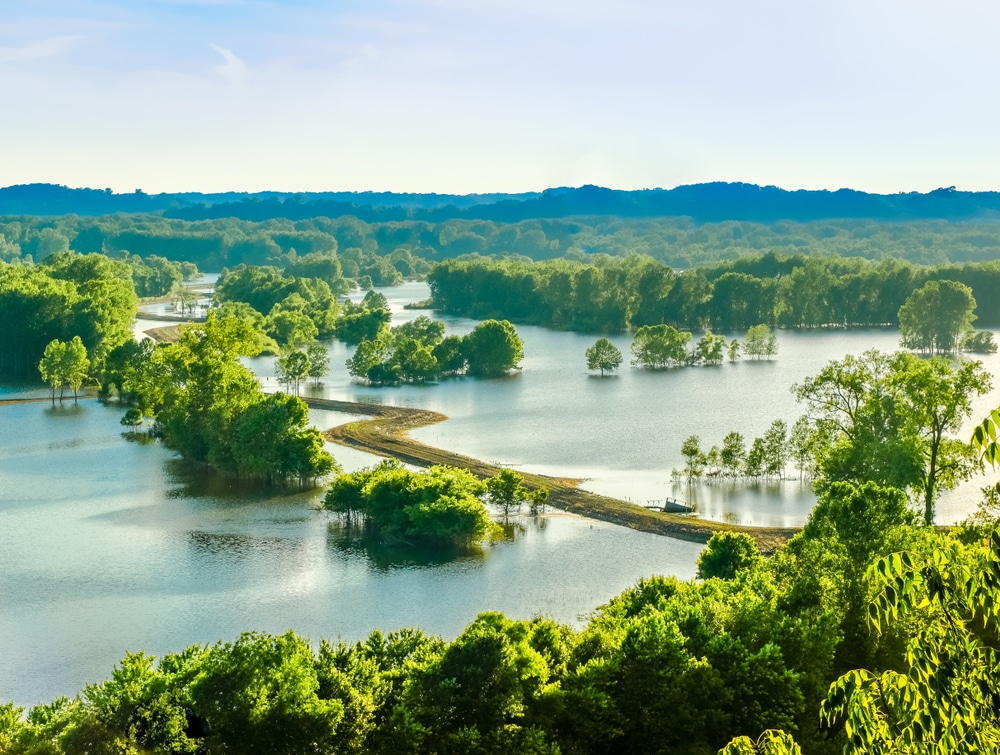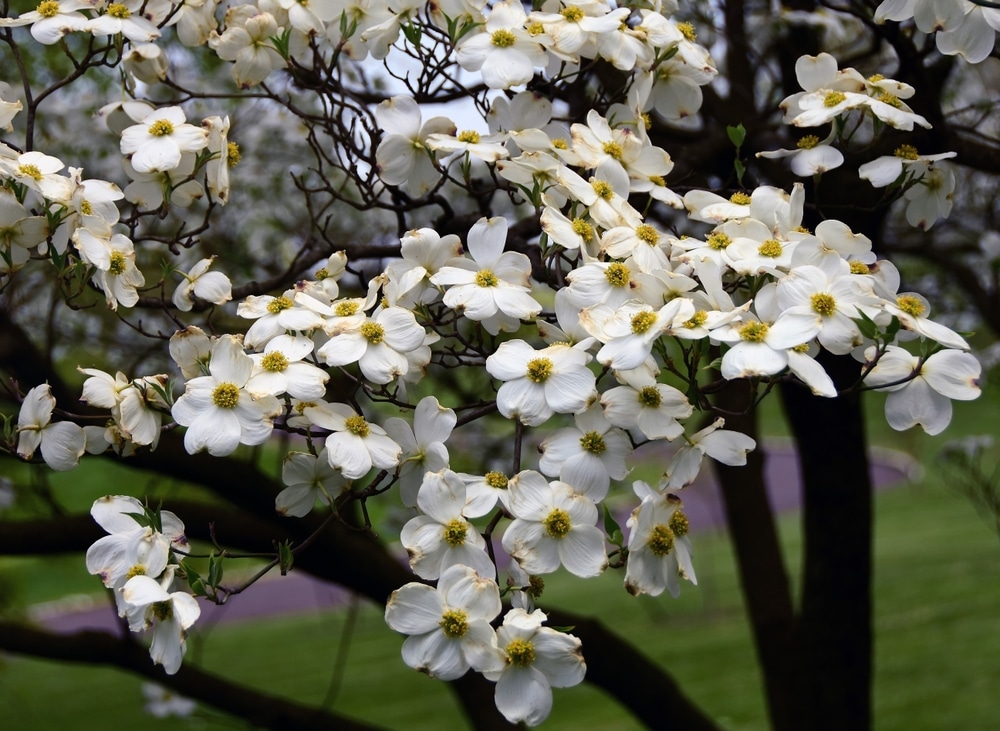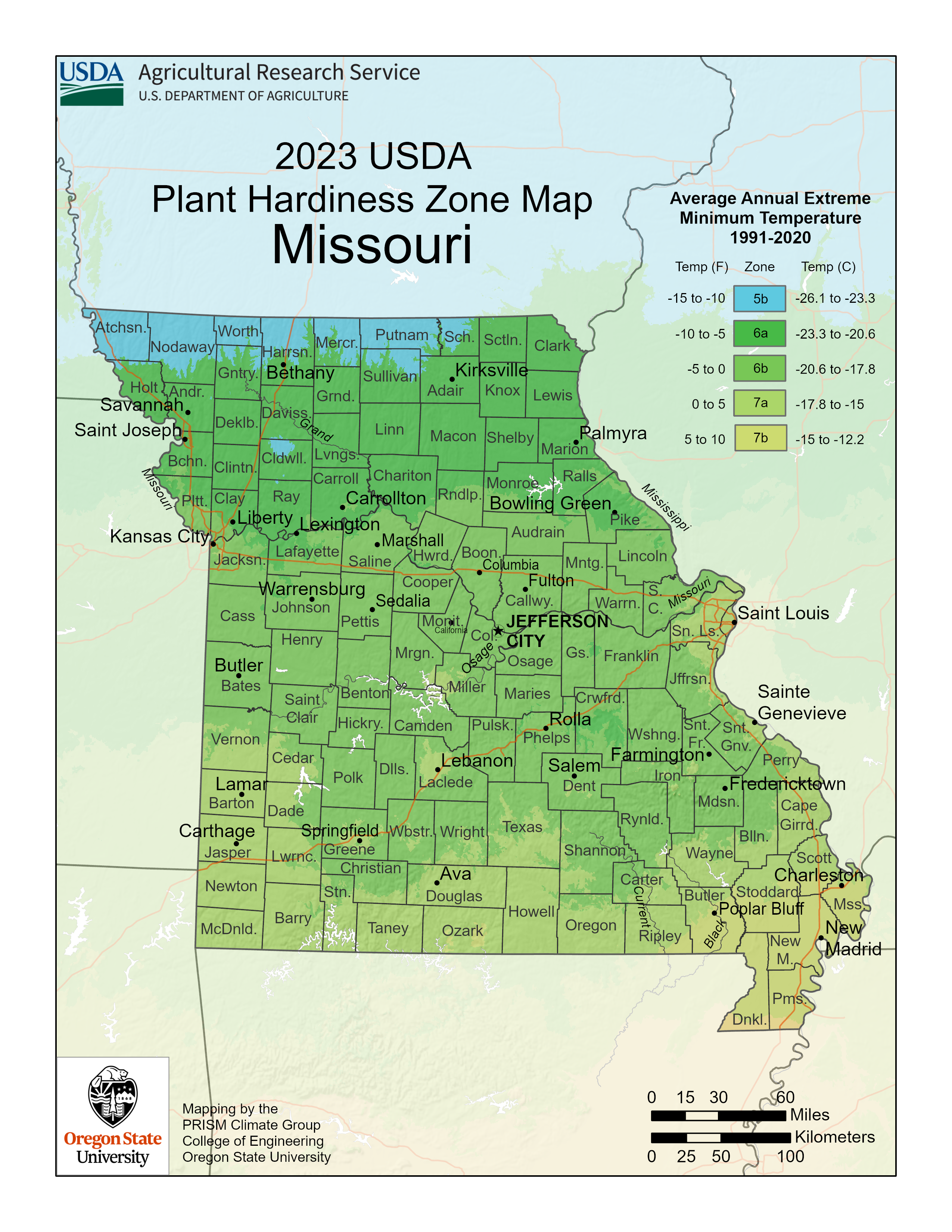Missouri Plant Hardiness Zones
| USDA Hardiness Zone | Average Minimum Winter Temperature Range Fahrenheit (°F) Celsius (°C) | Average Last Frost Date In Spring (Beginning Of The Growing Season) | Average First Frost Date In Autumn (End Of The Growing Season) |
|---|---|---|---|
| 5b | -15°F to -10°F -26.1°C to -23.3°C | May 1st – May 10th | October 11th – October 20th |
| 6a | -10°F to – 5°F -23.3°C to -20.6°C | April 21st – April 30th | October 21st – October 31st |
| 6b | -5°F to 0°F -20.6°C to -17.8°C | April 21st – April 30th | October 21st – October 31st |
| 7a | 0°F to 5°F -17.8°C to -15°C | March 22 – April 3 | November 1st – November 15th |
| 7b | 5°F to 10°F -15°C to -12.2°C | March 22 – April 3 | November 1st – November 15th |
Missouri Characteristics

General Climate
Missouri’s climate varies by region and is divided along a diagonal line running from the northwest to the southeast.
| Area | Climate | Details |
|---|---|---|
| Northern Third | Humid Continental | A region with four distinct seasons with large temperature differences. Hot, often humid summers and freezing cold winters (sometimes severely cold in northern areas) |
| Southern Regions | Humid Sub-Tropical | Hot, humid summers and cool to mild winters |
Missouri regularly experiences extreme temperature changes because of its inland location. It has no large mountains and isn’t close enough to oceans to moderate temperatures, so it can be influenced by cold arctic air from the north or warm, humid air from the Gulf of Mexico in the south. As a result, summer temperatures (during the growing season) can fluctuate as much as 20°F (about 11°C) or more in a 24-hour period and last for several days.
Microclimates
USDA plant hardiness zones are an important starting point for your garden, but you’ll also need to consider microclimates.
Microclimates are areas where specific conditions create a climate different from the climate they’re situated in.
Buildings, fences, paved areas, or short hills and valleys can create these microclimates.
They can be as small as a space in your backyard or as large as a city.
In other words, learn about your local conditions from local experts to see if your garden falls into a microclimate.
Droughts
Every year, some Missouri areas experience short periods of drought. However, abnormally dry-to-severe drought conditions are becoming more frequent and longer-lasting.
In 2023, for example, drought conditions affected most Missouri counties, with some in central Missouri experiencing extreme drought.
Abnormally dry conditions stress landscapes. Worsening conditions dry out topsoil, brown lawns, stress trees, and produce yields shrink. Extreme drought conditions can commonly cause mature tree death. Watering restrictions may compound these issues as well.
In addition, rainfall patterns are becoming more erratic. This can mean less summer rainfall overall. It also means less frequent extreme rainfall events but more rain when they happen.
All of this creates a chain reaction of issues:
- Long periods without rain dry out topsoil
- The topsoil can become compacted (packed down with hard surface)
- An extreme rainfall event happens
- The dry soil is unable to absorb all the water from that event
- It loses much of it in flooding
In short, due to all of the above issues, infrequent heavy rainfall cannot always replenish soil moisture levels to support plant life.
Extreme Weather
All of Missouri typically experiences extreme climate events. These events may be infrequent or happen in specific locations.
Events include:
- Heavy rainfalls (this likelihood decreases further to the north and east)
- Heat waves
- Cold spells
- Ice storms
- Wind storms
- Tornadoes
These events, in turn, can lead to other environmental changes, such as floods, landslides, or fires, all of which can lead to abrupt changes in the areas where plants grow.
Growing Season
Missouri’s growing season runs from about April through October or March to November and depends on its frost dates (seen in the table at the top of this page). While a region’s first/last frost dates generally coincide with its USDA hardiness zone, some overlap exists between them along zone boundaries.
Keep in mind local topography as well (hills, valleys, plateaus, etc.). These landscape changes can cause conditions to vary from the averages.
For example, the Ozark Plateau regions have higher elevations. As such, their last frost dates in the spring may be as much as two weeks later than the surrounding areas.
Check with your local garden centers for accurate details about your gardening region, and stay tuned to your local weather forecasts.
Missouri Gardening Tips

Missouri garden care needs to take into account the potential for sudden extreme changes in summer temperatures that can last for several days. Also, the prolonged severe drought conditions are happening more often. Drought conditions bring extreme heat and limited water in the soil available for plants.
Missouri gardeners need to think about what they can do to maintain their landscapes while at the same time reducing water use. This means choosing plants that can survive with less water, using mulch, and more.
Let’s start with choosing plants that can survive with less water.
Choose Plants That Can Survive With Less Water
Look for plants labeled as drought-tolerant (can grow with minimal water) or drought-resistant (they need some water but can survive for long periods without it).
Many of these plants have certain traits to help them survive using less water than others or when water suddenly becomes scarce, such as:
- They have an extensive root system to seek out water. These large root systems often make the plants hard to transplant (move) successfully.
- Silvery grey leaves
- Smaller leaves
- Tiny hairs, spines, or waxy coating on the leaves
- Some will roll or curl their leaves during hot, dry weather. The plant may look like it’s dying but will recover again when it gets enough water.
These plants can be annual (live for only one season) or perennial (come back year after year).
Young annuals need watering for a few weeks until they grow a strong root system. Newly planted perennials must be watered well for the first couple of years until they develop their extensive root system. This is especially important when planting young trees.
Good options for drought-tolerant flowering perennials include coneflower (echinacea), lavender (lavendula), and coreopsis.
Use Mulch
Mulching has many benefits, such as:
- Reducing moisture loss from the soil
- Keeping soil cooler in summer and warmer in winter, moderating soil temperatures, and reducing stress on plants
- Making garden beds look tidier and more attractive
- Protecting plants during dry spells
- Reducing water needed for irrigation
- Helping reduce weed growth
- Improving soil texture
- Preventing soil compaction and improving aeration of compacted soils
While many mulch options exist, you’ll gain more benefits from using organic mulch. Wood chips are one of the best options. They improve compacted soil, slowly release nutrients, stay in place, and last several seasons.
Other organic mulch options include compost, well-rotted manure, and bark chunks.
Gardening In Drought Conditions
Drought conditions stress plants. A water-stressed plant has weakened natural defenses and less energy to fight off pests and disease-causing pathogens.
Here are some things you can do to reduce drought stress for your plants:
- Add A Layer Of Mulch To Bare Soil Around Trees And Plants: This helps keep the soil and plant roots cooler and reduces water loss through evaporation from the soil
- Water Less Frequently And Deeply: This encourages roots to grow deeper, making plants more resilient during dry spells.
- Water In The Early Morning: Do this before the day’s heat increases evaporation. This allows more moisture to penetrate the soil and allow roots to access it.
- Avoid Watering Later In The Day: Wet overnight plants increase the risk of disease.
- Install A Drip Irrigation System: This applies water more efficiently directly to the roots.
- Choose Drought-Tolerant Or Drought-Resistant Plants: Many such plants exist, including native plants adapted to Missouri’s conditions.
- Don’t Apply Fertilizer To Water-Stressed Plants: These plants grow less during droughts, meaning they don’t need fertilizer. Additionally, applying a heavy dose of water-soluble fertilizer to a water-stressed plant can overdose the plant, causing damage to or killing foliage.
- Wait To Apply Fertilizer Until After Drought Conditions Have Passed: Even when it finally rains (or you water your plants) after a long period of drought, it can take some time for the soil and plants to recover and rehydrate. So, before applying fertilizer, water plants deeply and wait a day or two so they can rehydrate, then apply fertilizer and water deeply again.
Watering Strategies For Plant Health
Water practices affect plant health. It’s better to infrequently water so that it penetrates at least six inches into the soil than to do so lightly and often. Watering this way encourages roots to grow deeper into the soil, where they can withstand short dry periods better.
It is better to water plants early in the morning rather than later in the day or early evening. Moisture left on the plants overnight can encourage the development of diseases; most disease spores need wet surfaces to infect the leaves.
Remember to water the soil, not the foliage.
Winter Care
Shutting down your garden for the winter season is normal. However, there are winter gardening jobs you can do to prepare for this season. This starts with preparing for winter drying.
Prepare For Winter Drying
Cold winds cause evergreen leaves to lose moisture and dry out. Cold or frozen soil makes it difficult for roots to replace moisture as quickly as it’s lost.
Your evergreens will survive better if they start the winter well-hydrated. Thoroughly soak the soil around your evergreen plants just before the first frost if the summer or fall has been dry. This is especially important for evergreen trees and shrubs with extensive root systems. Water the soil around your trees as far as their branches extend (the “drip line”).
Use Burlap Wraps
Loosely wrap evergreens in burlap to protect them from winter winds. Wrapping them this way also allows their leaves to breathe.
Use Plant-Safe De-Icers
It’s normal to use de-icing products for personal safety in the winter. But these products can damage plants since they are usually salt-based, and the salt is toxic to plant cells.
When the ice melts, the salt washes into the surrounding soil or onto evergreen plants. This can kill leaves and needles and also the entire plant if it builds up in the soil, as the plant will soak this up when it takes in water in the spring.
In short, use de-icing products, indicating they are safe for use around plants.
Missouri Plant Suggestions

Trees
Evergreens
- Southern magnolia (Magnolia grandiflora)
- Flowering Dogwood (Cornus florida) (state tree)
- Black Hills spruce (Picea glauca var. densata)
Deciduous
- Eastern black walnut (Juglans nigra) (state nut tree)
- Eastern Redbud (Cercis canadensis)
- Black maple (Acer saccharum ‘nigrum’)
Shrubs
Evergreens
- Glossy abelia (Abelia grandiflora)
- Meserve hybrid hollies (Ilex x meserveaea) (zone 5,6,7)
- Japanese andromeda (Pieris japonica) (zone 6,7)
- Leatherleaf viburnum (Viburnum rhytidophyllum)
Deciduous
- Rose of Sharon (Hibiscus syriacus)
- American beautyberry (Calicarpa americana)
- Common witch hazel (Hamamelis virginiana)
Flowers
Annuals
- Lantana (many different species)
- Mexican zinnias (Zinnia haageana)
- Snapdragons (Antirrhinum majus)
Perennials
- Peony (Paeonia sp)
- Yarrow (Achillea millefolium)
- Milkweed (Asclepias syriaca)
- Coneflower (Echinacea sp)
Vegetables
- Sweet potatoes (Ipomoea batatas)
- Carrots (e.g. Bolero, Scarlet Nantes) (Daucus carota subsp. sativus)
- Heatwave II tomatoes (Solanum lycopersicum) (a hybrid tomato that matures early and has good high-heat tolerance)
Herbs
Many perennial herbs suffer winter damage in Missouri’s colder climate. They have shallow root systems that can heave out of the soil during early spring thawing and freezing cycles. Applying loose, deep mulching for the winter provides adequate damage prevention. Apply the mulch after the ground has frozen in early winter.
Or choose to grow annual herbs that will grow until killed off by the first frost.
Perennials
- Common thyme (Thymus vulgaris)
- Sage (Salvia officinalis)
- Mint (Mentha spicata)
Annuals
- Sweet basil (Ocimum basilicum)
- Cilantro/Coriander (Coriander sativum)
- Dill (Anethum graveolens)
- Parsley (Petroselinum crispum) (biennial)
Fruits
- Strawberries (Fragaria x ananassa)
- Apples (Malus domestica)
- Grapes (Vitis vinifera)

